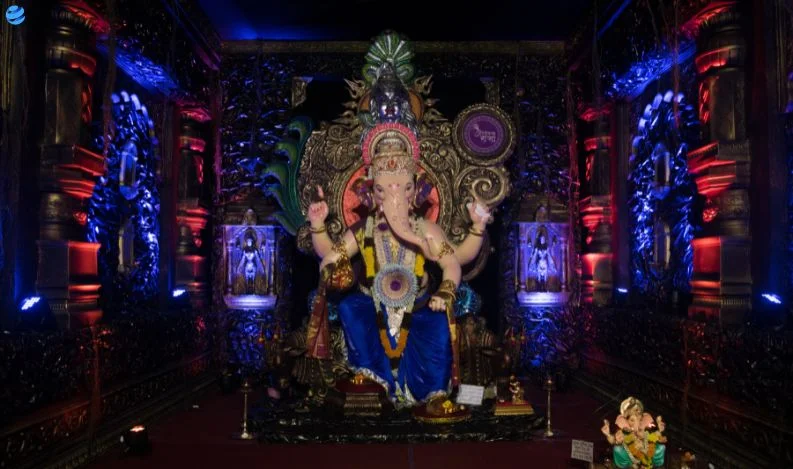Ganesh Chaturthi, a vibrant and widely celebrated Hindu festival, marks the birth of Lord Ganesha, the deity of wisdom, prosperity, and remover of obstacles. Celebrated across India with great enthusiasm, particularly in Maharashtra, it involves the installation of beautifully crafted clay idols of Ganesha in homes and public spaces, accompanied by prayers, songs, and dance. However, the festival is more than just a cultural event; it is steeped in deep mythological significance that sheds light on Lord Ganesha's origins, his role in Hindu mythology, and the symbolic meanings behind his unique appearance and stories. This blog delves into the mythological perspective of Ganesh Chaturthi, exploring the fascinating tales of Lord Ganesha and the underlying philosophies that guide his worship.
The Significance of Ganesh Chaturthi
Ganesh Chaturthi, also known as Vinayaka Chaturthi, is celebrated in the Hindu month of Bhadrapada (August-September), beginning on the fourth day (Chaturthi) of the waxing moon period. This ten-day festival is marked by fervent prayers, devotional singing, street processions, and the immersion of Ganesha idols in water bodies on the last day, called Anant Chaturdashi.
The festival signifies the cycle of birth, life, and death. The clay idols represent the cycle of creation and dissolution in nature, reflecting the idea that life is transient and everything returns to the Earth. The rituals of Ganesh Chaturthi are aimed at invoking the divine energy of Ganesha to eliminate negative energies, bring peace, and grant prosperity.
The Birth of Ganesha: A Tale of Divine Creation
The story of Ganesha's birth is one of the most popular legends in Hindu mythology. According to the most widely accepted narrative from the Puranas (ancient Hindu scriptures), Goddess Parvati, the consort of Lord Shiva, created Ganesha from the turmeric paste she used for bathing. She shaped the paste into a boy, breathed life into him, and assigned him the duty of guarding her chambers while she bathed.
When Lord Shiva, unaware of this newly created son, tried to enter the chambers, Ganesha, dutifully following his mother's instructions, stopped him. A fierce battle ensued between the two, resulting in Shiva beheading Ganesha in a fit of rage. Upon learning that Ganesha was Parvati's son, Shiva promised to bring him back to life. He instructed his followers to bring the head of the first creature they came across, which happened to be an elephant. Shiva placed the elephant’s head on Ganesha’s body, reviving him, and thus, Ganesha came to be known as the elephant-headed god.
This story is not only a testament to the complex familial dynamics of the divine but also symbolizes the concept of birth, death, and rebirth, mirroring the life cycle of human beings. The elephant head signifies wisdom and knowledge, while his human body represents earthly existence, making Ganesha a bridge between the spiritual and the material worlds.
Symbolism Behind Lord Ganesha’s Appearance
Lord Ganesha's unique appearance is rich in symbolism, each attribute carrying profound meaning:
-
Elephant Head: Represents wisdom, intelligence, and a discriminative mind. Elephants are known for their memory and strength, symbolizing Ganesha’s role as the remover of obstacles.
-
Large Ears: Symbolize the importance of listening and absorbing knowledge.
-
Small Eyes: Represent focus and concentration.
-
Large Belly: Signifies the ability to digest all that is good and bad in life.
-
Mouse (Vahana): Ganesha’s vehicle, the mouse, signifies the mind's ability to control desire and destroy ego. The small size of the mouse compared to Ganesha symbolizes humility.
-
Four Arms: Each arm holds a different object – a goad to remove obstacles, a noose to capture difficulties, a modak (sweet) symbolizing the rewards of spiritual practice, and an axe to cut off attachments and desires.
Each of these attributes illustrates the qualities needed for spiritual growth and worldly success, portraying Ganesha as a deity who embodies the balance between spiritual wisdom and worldly knowledge.
Ganesha's Role in Hindu Mythology: The Scribe of the Mahabharata
Apart from his birth story, another significant tale that highlights Lord Ganesha's importance in Hindu mythology is his role as the scribe of the epic Mahabharata. It is said that the great sage Vyasa needed someone to write down the epic as he recited it. He approached Ganesha, known for his intellect and wisdom, to undertake this monumental task.
Ganesha agreed on the condition that Vyasa would recite the epic without any pause, while Vyasa put forth his condition that Ganesha must understand each verse before writing it down. Thus began a remarkable collaboration, where Ganesha wrote continuously, and Vyasa, whenever needed, would compose a verse so profound that Ganesha would take a moment to understand it. This story highlights Ganesha's wisdom, patience, and intelligence, further establishing him as the patron of letters and learning.
The Curse of the Moon: The Story Behind Ganesh Chaturthi Superstition
A lesser-known story associated with Ganesh Chaturthi is the curse of the moon. It is believed that on the night of Ganesh Chaturthi, the Moon God, Chandra, laughed at Ganesha's potbelly and elephant head. This insult angered Ganesha, who cursed the moon, causing it to vanish from the sky. Realizing the repercussions of his curse, which would upset the natural order, Ganesha later modified it to say that anyone who looks at the moon on Ganesh Chaturthi would face false accusations and bad luck.
This story is often interpreted as a lesson against arrogance and mocking others based on their appearance. It also teaches that actions have consequences, and even gods must be mindful of their behavior.
The Ten-Day Festival: Rituals and Celebrations
Ganesh Chaturthi is a ten-day festival with elaborate rituals and celebrations that vary by region but follow a core pattern of worship and devotion. The first day begins with the installation of the Ganesha idol, known as Pranapratishtha, a ritual to invoke life in the idol. This is followed by Puja (worship) that includes the chanting of Vedic hymns, offerings of flowers, sweets, especially modaks (Ganesha’s favorite), and the singing of devotional songs.
Daily prayers and community gatherings are held, with large pandals (temporary structures) set up in cities where people can come and offer their respects. The festival culminates on the tenth day with Ganesh Visarjan, where the idols are carried in a grand procession and immersed in water bodies, signifying Ganesha’s return to his divine abode. The immersion also symbolizes the cycle of creation and dissolution in life.
Philosophical Lessons from Ganesha's Stories
The stories and symbolism associated with Ganesha are not just mythological tales; they hold deep philosophical and spiritual lessons:
-
Overcoming Obstacles: Ganesha's stories emphasize the importance of overcoming challenges through wisdom, patience, and determination.
-
Unity of Opposites: His elephant head on a human body symbolizes the unity of opposites, teaching us to harmonize our spiritual and material lives.
-
Humility and Knowledge: Ganesha's humility, despite his vast knowledge and power, is a lesson in modesty for humanity.
These lessons are timeless and resonate with people across different walks of life, making Ganesha a beloved deity who is worshipped first before any new venture or auspicious beginning.
Ganesh Chaturthi Across India: Diverse Celebrations and Customs
While Maharashtra is known for its grand Ganesh Chaturthi celebrations, the festival is observed across India in diverse ways:
-
Maharashtra: Known for its grand public celebrations, with large idols and huge processions, the spirit of community and collective devotion is palpable.
-
Tamil Nadu and Andhra Pradesh: Here, the festival is celebrated with traditional rituals and family gatherings, focusing on household worship and community prayers.
-
Goa: Celebrated with a strong emphasis on traditional rituals, including the Matoli, a canopy decorated with local fruits, flowers, and vegetables, under which the idol is placed.
-
Karnataka: Known as Vinayaka Chaturthi, the focus is on rituals like Ayudha Puja, where tools and instruments are worshipped as a gesture of thanksgiving.
Each region adds its unique flavor to the celebrations, reflecting India’s rich cultural diversity while maintaining the core essence of the festival.
Conclusion
Ganesh Chaturthi is more than a festival; it is a celebration of life, learning, and spiritual wisdom. The stories of Ganesha are filled with profound symbolism and philosophical depth that offer timeless lessons. The tales of his birth, his role as the scribe of the Mahabharata, and the curse of the moon, among others, provide a fascinating insight into Hindu mythology and its underlying teachings.
As devotees welcome Ganesha into their homes and hearts during Ganesh Chaturthi, they are reminded of the importance of wisdom, humility, and perseverance in overcoming life’s obstacles. Ganesha, the remover of obstacles, continues to inspire and guide millions of followers, making Ganesh Chaturthi a festival of not just devotion but also introspection and spiritual growth.
This blog will explore the mythological origins of Lord Ganesha, one of the most revered deities in Hinduism, and the significance of the Ganesh Chaturthi festival. It will delve into Ganesha’s symbolic role as the remover of obstacles and bringer of prosperity, examining the famous stories surrounding his birth and unique attributes. Through this narrative, readers will gain a deeper understanding of the cultural and spiritual importance of Ganesh Chaturthi, its rituals, and why millions of devotees celebrate this auspicious occasion with such fervor.














